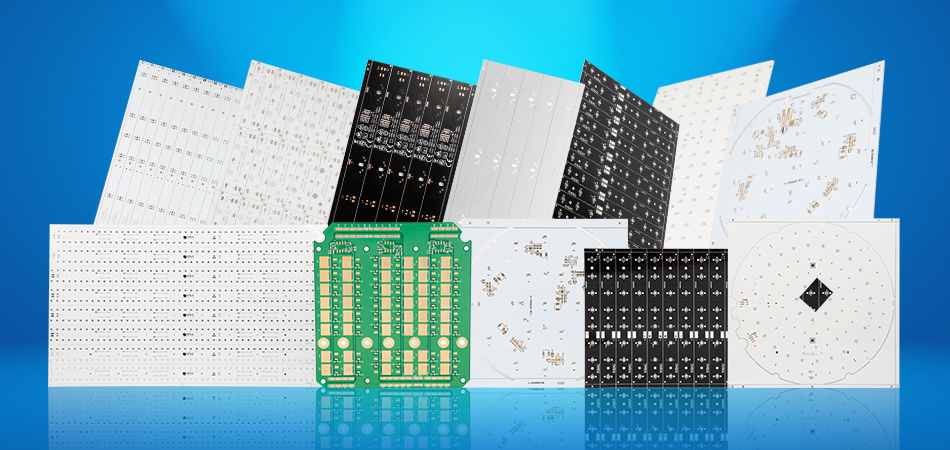-
- PCB TYPE
- PRINTED CIRCUIT BOARD PROTOTYPE ALUMINUM PRINTED CIRCUIT BOARD R&F PCB FPC HIGH FREQUENCY PCB HIGH-TG PCB HEAVY COPPER PCB HDI PCB PCB FOR LIGHTING METAL CORE PCB
time:Jun 16. 2025, 09:12:43
In the ever - advancing realm of electronics, where the demand for enhanced functionality and miniaturization continues to escalate, printed circuit boards (PCBs) have emerged as the unsung heroes of modern technological innovation. Among the diverse array of PCB technologies, high conductivity copper core PCBs stand out as a revolutionary solution, addressing the critical challenges of thermal management and electrical performance. These specialized PCBs have become indispensable in a wide range of applications, from high - power industrial equipment to cutting - edge consumer electronics. This article delves deep into the world of high conductivity copper core PCBs, exploring their unique features, design principles, manufacturing processes, applications, market dynamics, and future prospects.
Fundamentals of High Conductivity Copper Core PCBs
Definition and Basic Structure
A high conductivity copper core PCB is a sophisticated type of printed circuit board that integrates a copper layer as its core component. Unlike traditional PCBs, which typically rely on non - metallic substrates for mechanical support and electrical insulation, copper core PCBs leverage the exceptional thermal and electrical properties of copper to enhance overall performance. The structure of a copper core PCB typically consists of multiple layers. At the heart of the board lies the copper core, which serves as both a robust mechanical foundation and an efficient heat sink. Surrounding the copper core are layers of dielectric materials, such as prepregs or other insulating compounds, which provide electrical isolation while allowing for some degree of heat transfer. On the outer surfaces of the PCB, copper traces are patterned to form the electrical circuits that connect various electronic components, enabling the flow of electrical signals and power.
Key Material Properties
Copper, the primary material in these PCBs, boasts two key properties that make it ideal for high - performance applications: high thermal conductivity and excellent electrical conductivity. Its ability to rapidly conduct heat allows for efficient dissipation of heat generated by components mounted on the PCB, preventing overheating and ensuring stable operation. Simultaneously, copper's low electrical resistance enables the seamless transmission of electrical current, reducing power losses and improving the overall efficiency of the electronic system. These properties, combined with the mechanical strength of copper, make high conductivity copper core PCBs highly reliable and durable, capable of withstanding the rigors of various operating environments.

Design Principles of High Conductivity Copper Core PCBs
Thermal Design
Heat Transfer Mechanisms
Effective thermal design is crucial for high conductivity copper core PCBs to ensure optimal performance. The copper core plays a central role in heat transfer, acting as a heat sink to absorb and distribute heat away from heat - generating components. Heat is transferred from the components to the copper core through conduction, facilitated by thermal vias and direct contact. Once in the copper core, the heat is spread across its surface area and then dissipated into the surrounding environment through convection and radiation. To enhance heat dissipation, designers often incorporate additional heat - dissipating elements, such as heat sinks or fans, which work in tandem with the copper core to maintain lower operating temperatures.
Component Placement and Layout
The layout of components on a copper core PCB is a critical factor in thermal management. Heat - generating components should be strategically placed in close proximity to the copper core or in areas where heat can be efficiently transferred to it. For example, power - intensive components like power transistors and integrated circuits should be positioned directly above the copper core or connected to it via thermal vias. Additionally, proper spacing between components is essential to allow for adequate air circulation, which helps to dissipate heat through convection. In applications where forced air cooling is employed, the component layout should be designed to optimize the flow of cooling air, ensuring that all components receive sufficient cooling.
Electrical Design
Trace Routing and Impedance Control
In the electrical design of copper core PCBs, trace routing is a complex process that requires careful consideration of signal integrity, power distribution, and electromagnetic compatibility (EMC). For high - speed signals, impedance - controlled traces are essential to minimize signal reflections and ensure accurate data transmission. Designers must calculate and maintain the appropriate impedance values for the traces, taking into account factors such as trace width, spacing, and the dielectric constant of the insulating materials. Proper trace routing also involves avoiding signal crosstalk, which can occur when signals on adjacent traces interfere with each other. To mitigate crosstalk, designers may use techniques such as shielding, differential signaling, and proper trace separation.
Power and Ground Plane Design
Power and ground planes are integral components of the electrical design of copper core PCBs. Power planes are responsible for distributing electrical power to the various components on the board, while ground planes provide a common return path for electrical current. In copper core PCBs, the copper core can sometimes be utilized as a ground plane, taking advantage of its low resistance and high conductivity. Well - designed power and ground planes help to reduce voltage drops, minimize electromagnetic interference, and improve the overall efficiency of power distribution. To ensure optimal performance, power and ground planes should be continuous, with minimal splits or gaps, and should be carefully connected to the components on the board.
Manufacturing Processes of High Conductivity Copper Core PCBs
Material Preparation
The manufacturing process of high conductivity copper core PCBs begins with the selection and preparation of materials. High - purity copper is typically used for the core due to its superior thermal and electrical properties. The copper core is usually in the form of a copper sheet or foil, which is carefully inspected for any defects before further processing. Insulating materials, such as prepregs or other dielectric compounds, are selected based on their electrical insulation properties, thermal stability, and compatibility with the copper core. These materials are also inspected to ensure they meet the required quality standards.
Lamination
Lamination is a critical step in the manufacturing process, where the various layers of the PCB, including the copper core, insulating materials, and copper foils for traces, are bonded together to form a single, cohesive structure. The layers are carefully stacked in the correct order, and then heat and pressure are applied to cure the insulating materials and bond the layers together. The lamination process requires precise control of temperature, pressure, and time to ensure a strong and uniform bond between the layers. Any defects in the lamination process, such as voids or delaminations, can significantly impact the performance and reliability of the PCB.
Drilling and Plating
After lamination, drilling is performed to create holes for vias, component mounting, and electrical connections. High - speed drilling machines with specialized drill bits are used to ensure accurate and clean hole formation. Following drilling, the holes are plated with copper to create electrical connections between the different layers of the PCB and to provide a solderable surface for component attachment. Electroplating is a common method used for copper plating, where an electrical current is passed through the PCB in a copper - containing electrolyte solution to deposit copper ions onto the surface of the holes and the traces.
Circuit Patterning
Circuit patterning is the process of creating the electrical circuits on the copper surface of the PCB. Photolithography is a widely used technique for circuit patterning, where a photosensitive resist material is applied to the copper surface, and then a patterned mask is used to expose the resist to ultraviolet light. The exposed areas of the resist are then developed and removed, leaving behind the desired circuit pattern on the copper surface. The remaining copper is then etched away using an etching solution, leaving only the copper traces that form the electrical circuits.
Applications of High Conductivity Copper Core PCBs
Power Electronics
In the field of power electronics, high conductivity copper core PCBs are widely used in applications such as power supplies, inverters, and converters. These PCBs are essential for handling high currents and managing the heat generated by power - intensive components. In power supplies, the copper core helps to dissipate the heat generated by power transistors and other components, ensuring stable operation and preventing overheating. In inverters and converters, the high electrical conductivity of the copper core enables efficient power transfer, while the excellent thermal management properties help to maintain the reliability of the devices.
Automotive Electronics
The automotive industry has also embraced high conductivity copper core PCBs for a variety of applications. In engine control units (ECUs), these PCBs are used to handle the high - speed data processing and power requirements, while the copper core helps to dissipate the heat generated by the components, ensuring reliable operation in the harsh engine compartment environment. In electric vehicles (EVs), copper core PCBs are used in battery management systems, motor control units, and charging systems, where their high thermal and electrical performance is crucial for the efficient and safe operation of the vehicle.
Consumer Electronics
In consumer electronics, high conductivity copper core PCBs are increasingly being used in devices such as smartphones, laptops, and gaming consoles. These PCBs help to improve the performance and reliability of the devices by efficiently managing heat and ensuring stable electrical operation. In smartphones, for example, the copper core PCB helps to dissipate the heat generated by the processor and other components, preventing overheating and ensuring smooth operation. In laptops and gaming consoles, the high electrical conductivity of the copper core enables faster data transfer and improved performance.
Market Dynamics of High Conductivity Copper Core PCBs
Market Size and Growth
The global market for high conductivity copper core PCBs has been experiencing significant growth in recent years, driven by the increasing demand for high - performance electronics in various industries. The growing adoption of electric vehicles, renewable energy systems, and high - end consumer electronics is expected to continue to fuel the growth of the market in the coming years. Additionally, the ongoing trend towards miniaturization and integration of electronic components is also driving the demand for more advanced PCB technologies, including high conductivity copper core PCBs.
6.2 Competitive Landscape
The market for high conductivity copper core PCBs is highly competitive, with a large number of players operating in the industry. Key players in the market include both established PCB manufacturers and emerging companies that are focused on developing innovative PCB technologies. Competition in the market is based on factors such as product quality, performance, cost, and customer service. Companies are constantly investing in research and development to improve the performance and reliability of their products, as well as to reduce costs and increase production efficiency.

Challenges and Future Trends
Challenges
Despite the numerous advantages of high conductivity copper core PCBs, there are several challenges that need to be addressed. One of the main challenges is the high cost of copper, which can significantly increase the production cost of these PCBs. Additionally, the manufacturing process of copper core PCBs is more complex and time - consuming compared to traditional PCBs, which can also add to the cost. Another challenge is the need for more advanced design and manufacturing techniques to meet the increasing demands for higher performance and miniaturization.
Future Trends
Looking ahead, the future of high conductivity copper core PCBs is promising. Advancements in materials science and manufacturing technology are expected to lead to the development of more efficient and cost - effective copper core PCBs. The integration of new technologies, such as 5G, artificial intelligence, and the Internet of Things (IoT), is also expected to drive the demand for high - performance PCBs, including copper core PCBs. Additionally, the growing focus on sustainability and environmental protection is likely to lead to the development of more eco - friendly manufacturing processes for copper core PCBs.
Conclusion
High conductivity copper core PCBs have emerged as a game - changing technology in the field of electronics, offering superior thermal and electrical performance compared to traditional PCBs. These specialized PCBs are widely used in a variety of applications, from power electronics to consumer electronics, and are expected to play an increasingly important role in the future of technology. Despite the challenges, the future of high conductivity copper core PCBs looks bright, with continued advancements in materials science, manufacturing technology, and design techniques expected to drive further innovation and growth in the industry.

Got project ready to assembly? Contact us: info@apollopcb.com



We're not around but we still want to hear from you! Leave us a note:

Leave Message to APOLLOPCB
